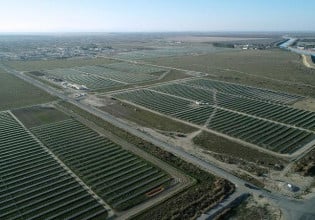LG Corp. announced today that it is introducing its "Complete Energy Value Chain," which promotes the production, storage and efficient use of eco-friendly energy, at Asia's leading biennial electric power supply event, which is taking place on Jeju Island, Korea from October 27 to 29. LG is introducing energy solution products and technologies from LG-affiliated companies, including LG Electronics, LG Chem and LG CNS.
The LG energy products and technologies on display at CEPSI include a solar module that offers the world’s best level output and efficiency, an Energy Storage System (ESS) that provides the world’s leading energy conversion efficiency, an ESS battery offering high energy output and long life, a Power Conditioning System (PCS) with a large capacity, and the world’s first ICT-based Smart Microgrid Solution (SMS) that combines ESS with an Energy Management System (EMS).
“At LG, the energy solution business is becoming one of our most important business segments as it is considered a future growth engine. I believe LG is well positioned in this sector since we can offer comprehensive solutions over the full range of the ‘Complete Energy Value Chain,’†said Sang-Yeop Baek, Senior Vice President of LG Corp. “We have already attracted many leading customers to our energy solution businesses, which include ESS, electric car batteries, Advanced Metering Infrastructure (AMI), SMS and more. I believe the CEPSI 2014 is an excellent venue to effectively showcase all of our cutting-edge products and technologies in the energy solution sector to a wide range of customers. I am confident that we can further expand our customer base by providing a full range of energy solution businesses.â€
LG Electronics is showcasing its solar module named, Mono X NeON, which produces an output of 300W and has a module efficiency of 18.3% based on a 60-cell module. And LG is showcasing a 100kW medium-large size ESS offering the world’s highest level energy conversion efficiency. LG Chem, the world’s leading ESS battery maker, is displaying various ESS batteries, including an ESS that replaces standby power for frequency regulation in conventional power plants, a Peak Shifting ESS that stores electricity generated during low industrial activity periods for use at peak industrial times, and a Renewable Integration ESS that stores, transmits and distributes electricity produced from renewable energy sources like solar and wind.
In addition, LG is showing a 1MW PCS. PCS is an essential component in an ESS because it converts Direct Current (DC) produced and stored from renewable energy sources like solar and wind into Alternating Current (AC). Last July, LG Chem built the world’s largest Peak Shifting ESS (23MWh) using three 1MW PCS units in parallel and it is the world’s first PCS working on such a large scale.
LG is also displaying technology that transmits, distributes and controls the energy in a stable and effective manner. This includes the Voltage Management System (VMS) which controls voltage for stable electricity transmission, and the AMI which measures the usage of electricity in offices and homes in real time for monitoring by electricity suppliers. The system also provides consumers with detailed information on their energy bills to encourage them in future energy conservation.
LG is exhibiting the Smart Microgrid Solution (SMS) which monitors and efficiently controls the overall status of energy generation, charging, discharging, and usage in homes, offices and cities by employing ICT. LG CNS has recently signed MOU with the Gyeongsangbuk-do provincial government and KEPCO, Korea’s main power company, to transform Ulleungdo Island, off Korea’s east coast, into an ‘Eco-friendly Energy Independent Island’, highlighting the company’s strength as a leading company in the SMS sector.
The company plans to turn Ulleungdo Island into the world’s first 100% eco-friendly energy independent island by 2020. The project includes the use of renewable energy sources such as solar and fuel cells to replace conventional diesel generation facilities. It will also apply converged/combined independent SMS systems to connect large electricity capacity saved by ESS to an EMS which manages the energy efficiently.






